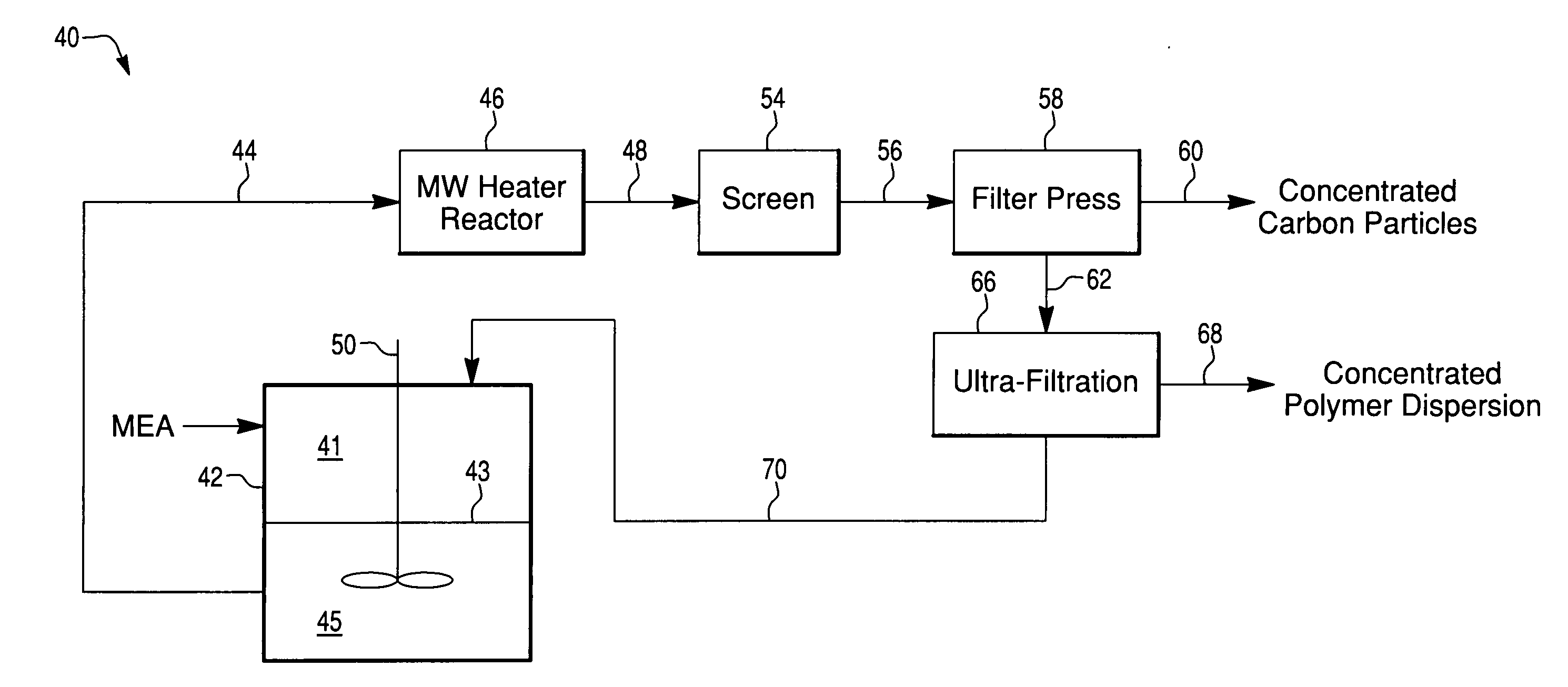Process for recycling components of a PEM fuel cell membrane electrode assembly
a technology of membrane electrode and fuel cell, which is applied in the direction of cell components, cell maintenance/service, separation process, etc., can solve the problems of high cost of proton exchange catalyst for fuel cell, the cost of efficient catalyst for low-temperature fuel cell is very high, and the total cost of such catalyst is approximately 80% of the total cost of manufacturing a low-temperature fuel cell
- Summary
- Abstract
- Description
- Claims
- Application Information
AI Technical Summary
Benefits of technology
Problems solved by technology
Method used
Image
Examples
example 1
[0042]Experiments were carried out on aged 5-layer MEAs with intact GDLs to compare loss of platinum (Pt) on the polymer membrane and / or on the GDL using different concentrations of isopropyl alcohol, 1-butanol and 2-butanol, See Table 1. The sample size used was 1 inch×1 inch in 20 ml of solvent, and the solvent volume was variable, estimated at 20 to 30 mL.
[0043]As can be seen from Table 1, loss of Pt on the polymer membrane and GDL were typically minimized with higher concentrations of alcohol.
TABLE 1Comparison of Pt Recovery from Aged MEAs by Solvent Delamination% Pt left onSolventTemperature% Pt left on GDLmembrane50% isopropanol1000.90.525% isopropanol1001.01.010% isopropanol100274225% 2-butanol1001.02.410% 2-butanol1000.51.710% 2-butanol1502.11.7 5% 2-butanol1003625% 1-butanol10010% 1-butanol1000.60.4
example 2
[0044]Used MEAs were tested in a batch mode for total recovery of Pt using various alcohol concentrations and temperatures. Samples (as ½×½ or 1×1 inch squares) were placed into plastic bottles with solvent, as described. The samples were then heated to a desired temperature using a microwave heating device and incubated for 30 minutes without agitation.
TABLE 2Comparison of recovery of Pt from aged MEAsSolventTemperature (° C.)Yield (%) 5% propanol15084.210% propanol1509825% propanol15096.6 5% propanol10011.810% propanol10030.425% propanol10098.1 5% n-butanol15094.510% n-butanol15093.325% n-butanol15094.9 5% n-butanol10095.910% n-butanol10098.925% n-butanol100100
example 3
[0045]Continuous
[0046]Used MEAs were tested in a batch mode for total recovery of Pt using various alcohol concentrations and temperatures. 1×1 inch samples were placed into plastic bottles with solvent, as described. After incubation the GDLs were separated from the carbon / polymer solution and sieved off. The solution was then pumped through a microwave heating device allowing for complete dispersion of the polymer. The solvent went from a translucent emulsion to a transparent dispersion. The carbon / noble metal (Pt) particles were separated from the dispersion using a filter press and the yield of recovered precious metal (Pt) quantified, see Table 3.
TABLE 3Comparison of recovery of Pt from MEAsusing a continuous processPt Yield (%) (basedMEASolventTemperature (° C.)on residual Pt)New25% n-butanol10098.5Used25% n-butanol10099Used25% n-butanol15097Used25% n-butanol / 15098.85% 2-propanol
PUM
| Property | Measurement | Unit |
|---|---|---|
| radius | aaaaa | aaaaa |
| radius | aaaaa | aaaaa |
| temperature | aaaaa | aaaaa |
Abstract
Description
Claims
Application Information
 Login to View More
Login to View More - R&D
- Intellectual Property
- Life Sciences
- Materials
- Tech Scout
- Unparalleled Data Quality
- Higher Quality Content
- 60% Fewer Hallucinations
Browse by: Latest US Patents, China's latest patents, Technical Efficacy Thesaurus, Application Domain, Technology Topic, Popular Technical Reports.
© 2025 PatSnap. All rights reserved.Legal|Privacy policy|Modern Slavery Act Transparency Statement|Sitemap|About US| Contact US: help@patsnap.com


